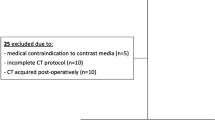Abstract
Objective
To investigate the characteristic findings in CT images associated with N-staging of rectal carcinoma.
Methods
Fifty nine patients underwent radical resection for rectal carcinoma after preoperative CT examinations. pN0, pN1, and pN2 were classified based on the pathological examination of excised specimens according to the AJCC N-staging criterion. Images were reviewed by two radiologists using CT cine blindly, reaching a consensus on size, number and distribution of lymph nodes, serosa behavior and circumferential infiltration of rectal carcinoma. The relationship between lymph node metastases and CT findings was analyzed statistically with SAS using k-w test and x 2 test.
Results
Lymph nodes were depicted in all node-positive cases. The mean diameters of the largest nodes displayed in the groups of pN0, pN1, pN2 were 3.84 mm, 5.60 mm and 6.79 mm respectively; the diameters showed a statistically significant increase with N-stage developing (H=23.842, P<0.01). The mean numbers of lymph nodes in the groups of pN0, pN1 and pN2 were 3.0, 4.5 and 9.0 respectively, which also showed an increasing trend and significant differences from each other (H=21.834, P<0.01). The summation diameters of all depicted nodes also showed a significant difference in the N0, N1 and N2 groups (H=32.037, P<0.001). Positive nodes were seen in 25% (3/12) of cases with perirectally displayed nodes, in 58.6%(17/29) of cases with lymph nodes distributed both perirectally and along the superior rectal artery, and in 72.7%(8/11) of cases with nodes detected along iliac vessels combined with either one of the previous two distributions patterns. The distribution patterns of lymph nodes were significantly different in N0, N1 and N2 groups (x 2 = 19.517, P<0.05). The disorder of serosa behavior and circumferential infiltration of rectal carcinoma were more likely to occur in node positive group than negative group with statistical significance (x 2=8.979, P<0.01, x 2=5.107, P<0.05).
Conclusion
Comprehensively considering the size, number, distribution of depicted lymph node, as well as serosa disorder and circumferential infiltration of rectal carcinoma would be helpful for improving the N-staging of CT in patients with rectal carcinoma preoperatively.
Similar content being viewed by others
References
Wong JH, Steinemann S, Calderia C, et al. Ex vivo sentinel node mapping in carcinoma of the colon and rectum[J]. Ann Surg 2001; 233: 515–521.
Spinelli P, Schiavo M, Meroni E, et al. Results of EUS in detecting perirectal lymph node metastases of rectal cancer: the pathologist makes the difference[J]. Gastrointest Endosc 1999; 49: 754–758.
Adam IJ, Mohamdee MO, Martin IG, et al. Role of circumferential margin involvement in the local recurrence of rectal cancer[J]. Lancet 1994; 344: 707–711.
Birbeck KF, Macklin CP, Tiffin NJ, et al. Rates of circumferential resection margin involvement vary between surgeons and predict outcomes in rectal cancer surgery[J]. Ann Surg 2002; 235: 449–457.
Kapiteijin E, Marijnen CA, Nagtegaal ID, et al. Preoperative radiotherapy combined with total mesorectal excision for respectable rectal cancer[J]. N Engl J Med 2001; 345: 638–646.
Glimelius BL. The role of preoperative and postoperative radiotherapy in rectal cancer[J]. Clin colorectal Cancer 2002; 2: 82–92.
Zaunbauer W, Haertel M, Fuchs WA, et al. Computered tomography in carcinoma of the rectum[J]. Gastrointest Radiol 1981; 6: 79–84.
Freeny PC, Marks WM, Ryan JA, et al. Colorectal carcinoma evaluation with CT: preoperative staging and detection of postopeprative recurrence[J]. Radiology 1986; 158: 347–353.
Grabbe E, Lierse W, Winkler R, et al. The perirectal fascia: morphology and use in staging of rectal carcinoma[J]. Radiology 1983; 149: 241–246.
Zhou CW, LI J, Zhao XM. Spiral CT in the preoperative staging of colorectal carcinoma-radiologico-pathologic correlation[J]. Chin J Oncol 2002; 24: 274–277.
Matsuoka H, Nakamura A, Masaki T, et al. Preoperative staging by multidetector-row computed tomography in patients with rectal carcinoma[J]. Am J Surg 2002; 184: 131–135.
Garcia-A J, Pollack J, Lee SH, et al. Accuracy of endorectgal ultrsonography in preoperative staging of rectal tumors[J]. Dis Colon Rectum 2002; 45: 10–14.
Zhao XM, Shi ML, Chen Y. The role of preoperative CT scan of rectal carcinoma[J]. J Clin Radiol 1999; 18: 218–221.
Zhang XP, Xu G, Sun YS, et al. The comparative study by helical CT in detecting rate of lymph node in the patients with stomach carcinoma and normal human[J]. J Prac Radiol 2002; 18: 872–874.
Tang L, Zhang XP. Detection of lymph nodes with CT in patients with gastric cancer: comparison of CT cine and film-based viewing[J]. Chin J Med Imaging Technol 2004; 20: 11–14.
Chiesura-Corona M, Muzzio PC, Giust G, et al. Rectal cancer: CT local staging with histopathologic correlation[J]. Abdominal Imaging 2002; 26: 134–138.
Hundt W, Braunschweig R, Reiser M, et al. Evaluation of spiral CT in staging of colon and rectal carcinoma[J]. Eur Radiol 1999; 9: 78–84.
Author information
Authors and Affiliations
Corresponding author
Additional information
Biography: ZHANG Xiao-peng (1962–), doctor of medicine, professor, Peking University School of Oncology, majors in image medicine.
Rights and permissions
About this article
Cite this article
Zhang, Xp., Li, J. & Sun, Ys. Diagnostic factor of N staging in rectal carcinoma: A computered tomography study corelated with pathological finding. Chin. J. Cancer Res. 18, 265–269 (2006). https://doi.org/10.1007/s11670-006-0265-9
Received:
Accepted:
Issue Date:
DOI: https://doi.org/10.1007/s11670-006-0265-9




